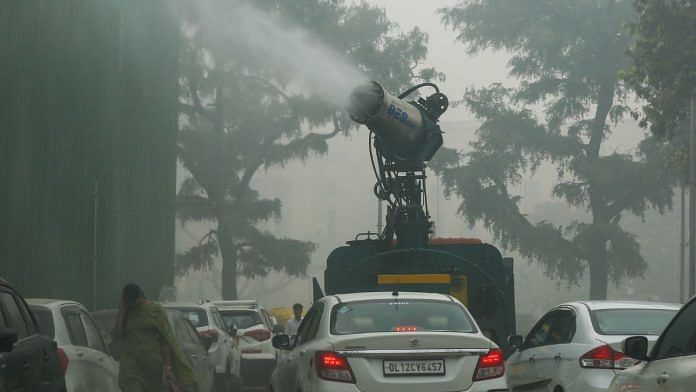
New Delhi: As the national capital is reeling under one of the worst pollution spells in history, the Delhi government is now pressing for cloud seeding to dissipate the thick layer of smog over the city while also actively considering emergency measures like the odd-even vehicle rationing. In a press conference Tuesday, Delhi environment minister Gopal Rai said he had written to his counterpart in the Union government, Bhupender Yadav, to allow artificial rains to disperse Delhi’s high pollution. He alleged that despite repeated reminders and requests, the Centre was yet to call a meeting to discuss the option.
“We have repeatedly written to the Union environment minister requesting him to call a meeting of experts and agencies and discuss artificial rain as an emergency measure to ease Delhi’s pollution. We have received no response,” Rai said. He also said that the government is in talks with experts to enforce emergency measures like odd-even and work-from-home options if the pollution levels in Delhi continue to remain in the severe-plus zone—above 450—in the coming days.

“We are talking to experts to see if odd-even needs to be brought in. We already have many restrictions for private vehicles under stage-4 of GRAP (Graded Response Action Plan), so we want to know how much more benefit can odd-even provide,” the minister said. Delhi has been experiencing an air pollution emergency for the last few days, with the air quality index (AQI) in the capital shooting up to 494—one of the worst pollution recordings in the past few years—Monday.
In many localities, the AQI maxed out at 500. While the winds picked up in the region by Monday evening, the high concentration of pollutants continued to keep the AQI above the 450 mark. At 1 pm Tuesday, the average AQI in Delhi was 471.
Also Read: US biologists win Nobel in Medicine for microRNA discovery. Here’s how it prevents diseases like cancer Delhi is not new to the odd-even vehicle rationing scheme. First implemented in 2016, the Aam Aadmi Party (AAP) government’s initiative aimed to control vehicular emissions in the city by only allowing private vehicles whose registration number ends with an odd number to ply on odd dates and even registration numbers to ply on even dates.
The vehicle rationing was enforced between 8 am and 8 pm on weekdays, and violators were fined Rs 2000. The government made special arrangements for additional buses and increased metro frequency to aid the restriction. But subsequent studies to assess the effectiveness of the exercise found that the scheme did not yield much benefit in bringing down the city’s pollution levels.
In 2023, a report submitted before the Supreme Court by amicus curiae Aparajita Singh said that vehicular pollution contributed 17 percent of Delhi’s total pollution. The odd-even scheme only brought this share down to 13 percent, which is an insignificant difference compared to the investment of resources required for its implementation. Cloud seeding or artificial rain is a weather modification technique that increases the amount of rain or snow that falls from clouds.
Rain is formed when water condenses around an aerosol particle (a “seed”), falling to Earth as it becomes heavy. When a cloud starts to become saturated, it can be stimulated by spraying particles into it and forcing it to release water in the form of rain. For instance, cloud seeding can be used to bring about rain in an area that is experiencing long periods of drought.
However, this will only work if the area or any nearby area has conducive conditions such as active clouds, which can be pushed to cause the required rainfall. Many top scientists have also questioned the effectiveness of this technique. “There are limitations of this technique.
We have to see if there are any seedable clouds over Delhi NCR to even consider it as an option to ease Delhi’s pollution levels,” a senior official from the Union Ministry of Earth Sciences told ThePrint. The official also said that these announcements seem like a diversion tactic by the state government to portray a sense of action from their end. “We are still experimenting with the technique, so there is no point pinning all your hopes on cloud seeding to bring down pollution.
” (Edited by Radifah Kabir) Also Read: 2024 Physics Nobel for AI scientists. How they pioneered machine learning modelled on human brain var ytflag = 0;var myListener = function() {document.removeEventListener('mousemove', myListener, false);lazyloadmyframes();};document.
addEventListener('mousemove', myListener, false);window.addEventListener('scroll', function() {if (ytflag == 0) {lazyloadmyframes();ytflag = 1;}});function lazyloadmyframes() {var ytv = document.getElementsByClassName("klazyiframe");for (var i = 0; i < ytv.
length; i++) {ytv[i].src = ytv[i].getAttribute('data-src');}} Save my name, email, and website in this browser for the next time I comment.
Δ document.getElementById( "ak_js_1" ).setAttribute( "value", ( new Date() ).
getTime() );.














